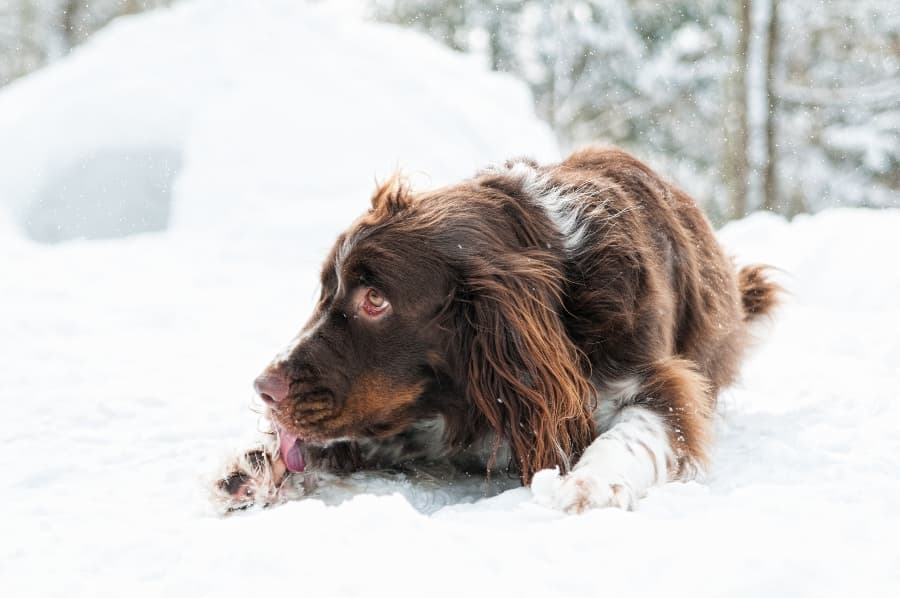
Extreme cold is not just unpleasant; it can be dangerous too. Dog frostbite is easily preventable with the right gear and safety practices.
Are you wondering, "Can dogs get frostbite on their paws?" Read on to find out more!
Extreme cold is not just unpleasant; it can be dangerous too. Dog frostbite is easily preventable with the right gear and safety practices.
Learn how to protect your dog from frostbite on dog paws, ears, and other vulnerable extremities in freezing temperatures.
Canadian winters can be pretty harsh with cold temperatures that can easily prove life-threatening, depending on which province you live in. This could mean you and your dog are dealing with some pretty frigid body temperature, not to mention the snow and ice that often come with it.
Can dog's paws get frostbite? YES!
Before we get into the tips and gear for preventing frostbite we'll learn what frostbite is and why it's so important that you take the proper precautions to prevent it.
Frostbite in Dogs During Cold Weather
Frostbite can occur at any cold temperature below freezing, but the colder it is, the faster frostbite can set in and the more severe the damage will be. For exposed skin, frostbite can set in as quickly as 30 minutes, and the colder and windier it is, the sooner frostbite can take effect and serious injury occur.
How to Prevent Dog Frostbite Tissue Damage
Frostbite is always better to prevent than treat, so ensure you take the proper precautions every time you take your dog out into extreme winter conditions.
Gear is important, and if you've never bought a dog coat before, dog boots and a snood might seem very silly, but they can save you a lot of trouble and keep your pet safe. Keep that in mind when prepping for your next winter walk.
Clinical Signs of Frostbite in Dogs

Whether or not your dog loves the cold, it's important to be able to recognize the signs of frostbite. No matter how routine or epic your dog's adventures in winter weather are, it's up to you to make sure he's not in danger of frostbite.
Dog frostbite symptoms include:
-
- Redness or extremely pale skin ulcers on affected areas
- Swelling or blistering
- Dog's pain medication or tenderness when touched
- Lifting paws when walking
- Reduced blood flow
- Seeking heat or shelter from the cold
- Weakness or mobility problems
- Black or dying tissue
- Reduced core temperature
- Curled or cracker nose or ear tips
- Focused fur loss
- Whining or barking
Stages of Frostbite in Dogs
Frostbite in dogs has three stages: frostnip, superficial frostbite, and severe frostbite in extreme temperatures. Recognizing these stages helps you decide when to bring your dog indoors and how to treat the condition.
-
Frostnip: The mildest stage, frostnip, causes redness and discomfort in the skin. It's common after short outings in extreme weather conditions when the blood vessels start to constrict. These are considered mild cases.
-
Superficial Frostbite: More severe, this level of frostbite results in pale skin and ulcers on affected skin. The skin may feel warm as damaged tissue attempts to heal. Swelling, blisters, and dead skin can appear within 12-36 hours after exposure to cold temperatures.
-
Deep Frostbite: Rare but dangerous, deep frostbite occurs from prolonged exposure to freezing temperatures or wetness. Skin turns grey or blueish, followed by large blisters and eventually blackened or dead skin indicating tissue death in severe cases.
In extreme cold, such as 40 below with windchill, frostbite can occur, potentially leading to tissue necrosis (severe tissue injury) and dangerously low body temperature. It's crucial to keep your dog warm in such severe temperatures.
The most commonly affected areas of frostbite on dogs include dog paws and paw pads, ears, and their nose.
How to Treat Frostbite in Dogs
Take your canine companion to a veterinarian. Your vet will examine the affected body part for clinical signs to determine if it has experienced frostbite. The vet may prescribe pain medications. You should never give your dog human prescribe pain medication or use human pain relievers without consulting with your veterinarian.
Step 1: Bring Them Inside During Extreme Cold
You should immediately bring your dog to a warm place at the first signs of frostbite. Your house or car is ideal to help get the pet dry and slowly warm up affected tissues. You'll then want to embark on a treatment plan.
Step 2: Grab a Blanket or Warm Towel
The next step is to start warming them up. This process needs to be done slowly, so start by grabbing a blanket or some dry towels and gently wrap your dog.
As the affected tissue warms up, their body parts will start to dilate the small blood vessels in their extremities to warm the affected area naturally. The vital organs will also warm.
Your body heat can also be helpful, so for smaller pets, you can hold them in your lap or cuddle up next to a bigger pooch to share warmth.
Step 3: Warm Around Your Dog's Body
Increase the ambient temperature of the room you are in. Hot water bottles or small space heaters set on low can be used to raise the temperature of the room very gradually.
Use direct heat from a heating pad.
Don't put the heaters or water bottles on your dog, though. This can warm the area quickly or even burn the already sensitive and damaged skin.
You can even use a hair dryer set to low temperature to warm up your pup's paws and other affected body parts.
Step 4: Defrost the Affected Area
Once your dog has been stabilized and is safely warming, you can focus on the severely affected areas of your dog.
You can use tepid or lukewarm water to stop further tissue damage to extremities that were most affected by the cold.
This means that it should be barely warm. Think about core body temperature and how frost bite can reduce blood flow to the extremities.
Water compresses about 100 F will feel slightly warmer than your skin, so when you stick your finger in it, it should almost feel like nothing. This is ideal for mild cases.
This is especially helpful if you are dealing with a frostbitten paw that is covered in ice or snow and has reduced blood flow in the affected body area. This can loosen the debris quickly so that you can better see the extent of the frostbite damage.
You'll probably need to change the water after you've removed all the ice.
Step 5: Protect the Affected Area
Whenever possible, protect the area. This could mean putting a cone on your dog to remove access to the area.
If you have to, wrapping the wound is an option, but healing wounds need to breathe to heal, so it's not the ideal solution.

At-Home Dog Frostbite First Aid
To help you act quickly and limit long-term damage, we put together a quick 5-step list for treating frostbite at home. Remember to call your vet as soon as you get your pet dry to safety for directions and the next steps.
-
Bring Them Inside
-
Grab a Blanket and Warm Dry Towels
-
Warm Around Your Dog
-
Defrost the Affected Area
-
Protect the Affected Area
Frequently Asked Questions About Dog Frostbite

How quickly can a dog develop frostbite?
Frostbite can develop after as little as 20-30 minutes of exposure to extreme cold. Indications of frostbite must be addressed immediately.
What is frostbite in dogs?
Frostbite happens when a dog's skin and tissues freeze due to exposure to extremely cold temperatures, particularly in areas with low blood flow, like ears, paws, and tail.
How can I tell if my dog has frostbite?
Signs of frostbite include pale or discoloured skin, cold or brittle areas on the body, swelling, and pain in severe cases. Your dog might also lick, chew, or show discomfort in the affected areas.
What should I do if I suspect my dog has frostbite?
If pet parents suspect frostbite, immediately move your dog to a warm environment and gently warm the areas with lukewarm water. Avoid rubbing or using hot water; seek immediate veterinary care before permanent damage occurs.
Are certain dog breeds more susceptible to frostbite?
Breeds with shorter coats, smaller body sizes, and less insulation, like toy breeds and short-haired dogs, are at greater risk of frostbite. Senior dogs and those suffering from diabetes mellitus are also at increased risk of developing extreme cases of frostbite in their deeper tissues.
How can I prevent frostbite in my dog?
Protect your dog from cold weather with appropriate clothing like coats and boots. Limit time spent outdoors in very cold conditions, and ensure your dog has a warm, sheltered area to seek refuge from the cold.
.png?width=200&height=66&name=logo%20(1).png)



.jpg)
